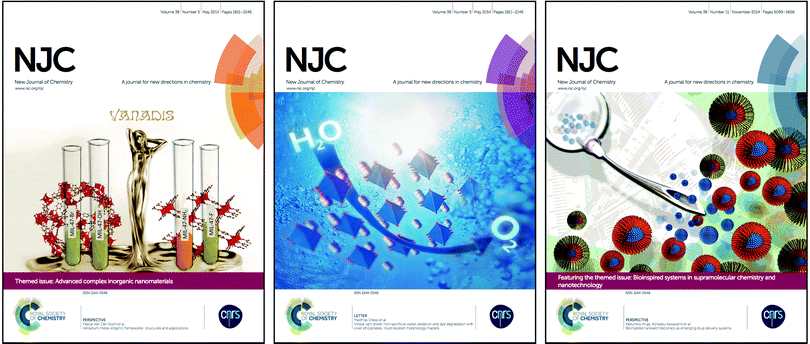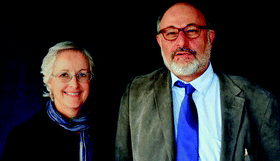NJC in 2015: thirty-nine years and counting
A few words about NJC
In 2015, New Journal of Chemistry will enter its 39th year of publication as a general chemistry journal. Founded in 1977 by CNRS researchers, the journal has been published by the Royal Society of Chemistry (RSC) since 1998.Editorial policy
NJC seeks to publish high quality papers in any area of chemistry that can potentially interest a broad readership within the chemistry research community. Submissions must include a strong chemistry component and report new findings that are of significant importance to other researchers in the field.Editorial staff
The main editorial office is based in Montpellier, France, while production of the journal is assured by the RSC from its Cambridge office in the UK.Currently there are 7 editors (Fig. 1) who handle submitted manuscripts through peer review and editorial decision:
• Drs Denise Parent and Eva Balentova are the full-time CNRS staff in the Montpellier office;
• Editorial Board members Prof. Peter Junk (James Cook University, Australia) and Prof. Jaïrton Dupont (UFRGS, Brazil; moving soon to the University of Nottingham, UK) serve as associate editors;
• Drs Ling Peng, Yannick Guari and Laurent Vial (CNRS researchers) carry out editorial duties on a part-time basis as assistant editors.
For the Royal Society of Chemistry, Executive Editor Sarah Ruthven is seconded by Guy Jones in the Cambridge editorial office, while Andrew Shore and the team of editors handle production.
We are interested in hearing from experienced PhD research chemists (actively working or recently retired) with a record of publication in quality journals who would be interested in joining the editorial staff as part-time assistant editors on a voluntary basis. Inquiries should be addressed to Dr Denise Parent in the Montpellier editorial office.
Looking back on 2014
Metrics and editorial procedures
The editors of NJC were pleased to see that the impact factor increased again in 2014 to reach its highest ever value of 3.159. Submissions to NJC increased by 40% this year, following a similarly strong increase in 2013. To maintain the quality of the papers that are published in NJC, NJC editors carry out a preliminary evaluation of all submitted manuscripts. Both the content and the presentation of the manuscript are considered in this first phase of evaluation. The significance of the results and the suitability of the presentation for a general chemistry audience are evaluated to determine if the manuscript will undergo full peer review by specialists. Failure to follow the RSC’s ethical guidelines is also grounds for rejection.Editors are also bound to follow ethical procedures, which include carrying out the evaluation process in a confidential and impartial manner and making editorial decisions based solely on the journal's editorial policy and the scientific evaluation of the manuscript.
The full RSC ethical guidelines can be found at http://www.rsc.org/Publishing/Journals/guidelines/EthicalGuidelines/EthicalGuidelinesandConflictofInterest/index.asp.
Appeal of a rejection can be considered by the editors only if the authors show that the decision is based on significantly erroneous remarks by the reviewers (or editor in the case of a direct rejection), such that additional review is necessary to fairly evaluate the manuscript.
Content
Two themed issues (Fig. 2) were published in 2014.• The “Advanced Complex Inorganic Nanomaterials” issue published in May was guest-edited by Professors Yann Garcia (Catholic University of Leuven, Belgium) and Bao-Lian Su (University of Namur, Belgium). The 39 contributions, including 10 review articles, covered the latest advances and preparation methods of materials ranging from coordination polymers and organometallic frameworks to spin-crossover nanomaterials. Several papers presented applications of these various nanomaterials, including heterogeneous catalysis, adsorption, and use in energy-related devices.
• The November issue included 17 contributions (of which 7 are reviews) on the theme of “Bioinspired Systems in Supramolecular Chemistry and Nanotechnology”. The guest editors were Professors Michel Camplo, Jean-Manuel Raimundo (Aix-Marseille University, France), Mark W. Grinstaff (Boston University, USA), Laurence Navailles and Philippe Barthélémy (University of Bordeaux, France). Major themes of the issue included self-assembly, hybrid systems based on biomolecules, and biomedical applications.
• The contents lists can be seen at http://pubs.rsc.org/en/journals/journalissues/nj#!themedcollections.
A variety of Focus and Perspective reviews were published in 2014, as listed in Table 1. The short (6-page) Focuses present a personal view of a topic of current interest. Their short length is designed to make them readable by non-specialists of the field. They give a concise introduction to the topic covered, including key achievements and perspectives, drawing on a limited number of references to the most important papers.
| DOI | Title | Authors |
|---|---|---|
| Focus reviews | ||
| 10.1039/C3NJ01008B | Filling carbon nanotubes for nanobiotechnological applications | Riccardo Marega and Davide Bonifazi |
| 10.1039/C3NJ00667K | Triazolium cations: from the “click” pool to multipurpose applications | Jesus M. Aizpurua, Raluca M. Fratila, Zaira Monasterio, Nerea Pérez-Esnaola, Elena Andreieff, Aitziber Irastorza and Maialen Sagartzazu-Aizpurua |
| 10.1039/C3NJ01155K | Shape-controlled synthesis of ruthenium nanocrystals and their catalytic applications | Guozhu Chen, Jianming Zhang, Akanksha Gupta, Federico Rosei and Dongling Ma |
| 10.1039/C3NJ01268A | Finite size effects in molecular spin crossover materials | Mirko Mikolasek, Gautier Félix, William Nicolazzi, Gábor Molnár, Lionel Salmon and Azzedine Bousseksou |
| 10.1039/C3NJ01255G | Photoswitchable spin crossover nanoparticles | Antoine Tissot |
| 10.1039/C3NJ01556D | Water and methanol adsorption on MOFs for cycling heat transformation processes | Felix Jeremias, Dominik Fröhlich, Christoph Janiak and Stefan K. Henninger |
| 10.1039/C4NJ00099D | Carbonylative diversification of unactivated heteroaromatic compounds | Rui Lang, Chungu Xia and Fuwei Li |
| 10.1039/C4NJ00016A | Recent progress on the tailored synthesis of various mesoporous fibers toward practical applications | Norihiro Suzuki, Jian Liu and Yusuke Yamauchi |
| 10.1039/C4NJ00665H | Guanosine and isoguanosine derivatives for supramolecular devices | Valentina Abet and Raphaël Rodriguez |
| 10.1039/C4NJ00850B | A hybrid lipid oligonucleotide: a versatile tool for supramolecular chemistry | Arnaud Gissot, Khalid Oumzil, Amit Patwa and Philippe Barthélémy |
| 10.1039/C4NJ00894D | Compartmentalised chemistry: from studies on the origin of life to engineered biochemical systems | Pawel L. Urban |
| 10.1039/C4NJ00914B | Self-assembly of fatty acids: from foams to protocell vesicles | Jean-Paul Douliez and Cédric Gaillard |
| 10.1039/C4NJ00655K | The intrinsic view of ionization equilibria of polyprotic molecules | Michal Borkovec, Ger J. M. Koper and Bernard Spiess |
| Perspective reviews | ||
| 10.1039/C3NJ00535F | Diamondoids: functionalization and subsequent applications of perfectly defined molecular cage hydrocarbons | Maria A. Gunawan, Jean-Cyrille Hierso, Didier Poinsot, Andrey A. Fokin, Natalie A. Fokina, Boryslav A. Tkachenko and Peter R. Schreiner |
| 10.1039/C3NJ01130E | Vanadium metal–organic frameworks: structures and applications | Pascal Van Der Voort, Karen Leus, Ying-Ya Liu, Matthias Vandichel, Veronique Van Speybroeck, Michel Waroquier and Shyam Biswas |
| 10.1039/C3NJ00835E | Recent advances in the synthesis and applications of 2,6-dipyrazolylpyridine derivatives and their complexes | Malcolm A. Halcrow |
| 10.1039/C3NJ00888F | Hollow micro/nanostructured materials prepared by ion exchange synthesis and their potential applications | Chenglin Yan and Federico Rosei |
| 10.1039/C3NJ01139A | Mesoporous non-siliceous inorganic–organic hybrids: a promising platform for designing multifunctional materials | Yun-Pei Zhu, Tie-Zhen Ren and Zhong-Yong Yuan |
| 10.1039/C3NJ01612A | Ordered mesoporous polymer-derived ceramics and their processing into hierarchically porous boron nitride and silicoboron carbonitride monoliths | Samuel Bernard and Philippe Miele |
| 10.1039/C3NJ01451G | Spin crossover with thermal hysteresis in cobalt(II) complexes and the importance of scan rate | Reece G. Miller, Suresh Narayanaswamy, Jeffery L. Tallon and Sally Brooker |
| 10.1039/C3NJ01239E | Advances in the chemistry of dendrimers | Marta Sowinska and Zofia Urbanczyk-Lipkowska |
| 10.1039/C3NJ01537H | Triphenylamines and 1,3,4-oxadiazoles: a versatile combination for controlling the charge balance in organic electronics | Frédéric Dumur and Fabrice Goubard |
| 10.1039/C4NJ00304G | Experimental and theoretical methods for the analyses of dynamic combinatorial libraries | Maria Cristina Misuraca, Emilie Moulin, Yves Ruff and Nicolas Giuseppone |
| 10.1039/C4NJ00864B | Bioinspired nanoarchitectonics as emerging drug delivery systems | Katsuhiko Ariga, Kohsaku Kawakami, Mitsuhiro Ebara, Yohei Kotsuchibashi, Qingmin Ji and Jonathan P. Hill |
| 10.1039/C4NJ01314J | Cationic liposome–nucleic acid complexes for gene delivery and gene silencing | Cyrus R. Safinya, Kai K. Ewert, Ramsey N. Majzoub and Cecília Leal |
| 10.1039/C4NJ00755G | Supramolecular immobilization of bio-entities for bioelectrochemical applications | Michael Holzinger, Alan Le Goff and Serge Cosnier |
The longer Perspectives provide a more detailed review of a selected area of research, typically through a survey of the author's contributions to the field, put into the context of current and past research. The review concludes with a personal perspective on the future of the field.
2014 NJC Symposia Series 3
After France in 2011 and China in 2012, the NJC Editorial Board travelled to Sweden for the 3rd NJC Symposia Series. NJC Board member Prof. Christina Moberg hosted at the KTH in Stockholm, while Prof. Ola Wendt was our host at Lund University. The programme of each day-long symposium was made up of talks by NJC Board members and local guest speakers. Full details and the scientific programmes can be found on the NJC Blog (http://blogs.rsc.org/nj/2014/01/17/announcing-the-2014-njc-symposia-in-sweden/ and http://blogs.rsc.org/nj/2014/04/22/update-for-the-njc-symposia-in-sweden/).Looking forward to 2015
NJC symposia and conferences
At the time of writing, the location of the 2015 NJC Symposia has not yet been determined. Will the NJC Board return to China, visit North America or stay closer to home by going to the UK? The choice will be announced on the NJC blog (http://blogs.rsc.org/nj/).The NJC blog is also where we post the list of conferences that NJC editors will be attending, with updates throughout the year. Keep an eye on the blog to see where you can meet an NJC editor in 2015!
Themed issues
Themed issues are in the planning stages for publication in 2015 and later.• An issue on Foldamers guest-edited by Prof. David Aitken (University of Paris XI, France) is in preparation for publication in the spring.
• Later in the year a themed issue on the “Frontiers of Organo-f-element Chemistry” will appear, guest edited by Professors Frank Edelmann (University of Magdeburg, Germany) and Peter Junk (see the call-for-papers at http://blogs.rsc.org/nj/2014/08/18/njc-call-for-papers-frontiers-of-organo-f-element-chemistry-themed-issue/).
• An announcement and call-for-papers in the area of “Emergent Polyoxometalates and Soft Oxometalates” [with Professors Debbie Crans (Colorado State University, USA) and Soumyajit Roy (IISER Kolkata, India) as guest editors] will also be available at http://blogs.rsc.org/nj/category/themed-issue/.
40th anniversary
How should NJC celebrate its 40 years of existence? Your ideas are welcome! Contact the editorial office in Montpellier.Thanks and best wishes for 2015
We thank our authors for their confidence in NJC. We endeavour to offer personalised service to our authors. Specific editorial suggestions and targeted publicity of accepted manuscripts are just two of our actions designed to provide an extra service.With the increase in submissions, qualified reviewers are more and more in demand. We warmly thank all of those who help the editors select the best work to publish in NJC.
Readers are critically important to us as well. We encourage you to sign up for the e-alerts (http://www.rsc.org/Publishing/Journals/forms/V5profile.asp) so as not to miss a single issue of NJC, to send us your feedback on how we can make the journal better, and to cite NJC articles when relevant to your work.
Others who contribute to the continuing success of NJC are the editors and Board members, and we thank them for their efforts on behalf of the journal.
We wish all of you the very best in 2015!
Looking forward by looking further—beyond the traditional boundaries—NJC presents chemistry as the central science.
2014 Impact Factor: 3.159
Mir Wais Hosseini Editor-in-Chief
Denise Parent (CNRS; E-mail: NJC@um2.fr)
Staying informed
Read NJC at: www.rsc.org/njcEditorial Boards at: www.rsc.org/publishing/journals/nj/staff.asp
Learn more at: http://www.njc.cnrs.fr/?lang=en
More news at: http://blogs.rsc.org/nj/
Prefer French?: http://www.njc.cnrs.fr
Submit at: http://mc.manuscriptcentral.com/njc
Contact us at: E-mail: njc@um2.fr; or njc@rsc.org
| This journal is © The Royal Society of Chemistry and the Centre National de la Recherche Scientifique 2015 |



